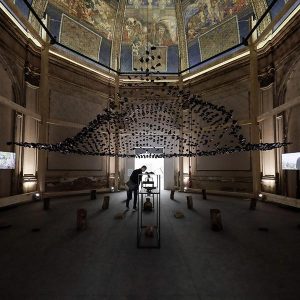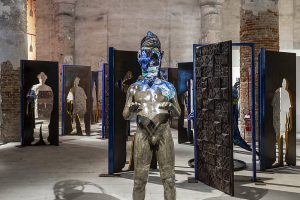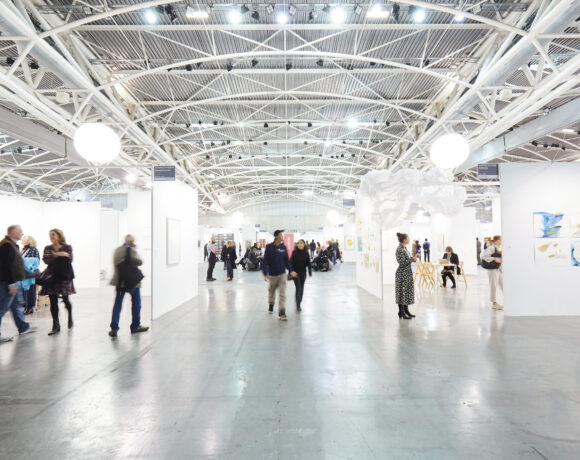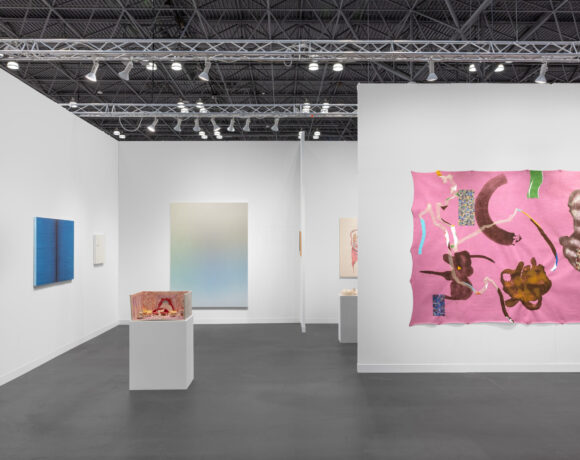While the Africa 2020 Season is taking place in France, festival dedicated to the 54 states of the African continent, with the deployment of fifteen Headquarters (HQ) from 25 June to 8 November 2021, and African Galleries Now and 1–54 Contemporary African Art Fair New York have been launched on Artsy, it may be interesting to note how at the Venice Architecture Biennale 2021, curated by Hashim Sarkis, large installations by African artists open both the Central Pavilion at the Giardini and the long path of the Arsenale, projected one into a distant past and the other in a dystopian future.
At the Central Pavilion at the Giardini we find The Anthropocene Museum: Exibit 3.0 Obsidian Rain (2017) by Cave_Bureau composed by Kenyans Kabage Karanja and Stella Mutegi, an architect and researchers studio based in Nairobi which explores through architecture and urban planning the natural environment with geological and anthropological investigations, research, expeditions and surveys in the caves inside the Great Rift Valley. Stella Mutegi is the director and founder of Cave_bureau, heads the technical department of Cave, and is also involved in the investigation of caves in the Great Rift Valley. Cave_Bureau is the first Kenyan studio to debut at the 2021 Venice Architecture Biennale.
Obsidian Rain is an installation composed of 1,600 obsidian stones collected from Gilgil, Kenya, hung at precise heights from a wooden and mesh structure to replicate a section of the roof of the Mbai caves on the outskirts of Nairobi, the hometown of Karanja. Inside, visitors can rest on the trunks of an African cedar, which also came from Kenya. Caves are important in Kenya’s recent history; in the 1950s the Mau Mau fighters gathered there to hide and regroup after the clashes with the British in Nairobi. It was, as Karanja said, a place of “deep contemplation” for resistance fighters “to consider what the future African state would be”. The Anthropocene Museum takes its name from what National Geographic has defined as an “unofficial unit of geological time”, starting with the Industrial Revolution, when human activity began to have a substantial impact on the ecosystems and climate of the land.
At the Arsenale, as soon as you enter, you are immersed in the sculptural installation of the Nigerian Peju Alatise (1975) from Art Accent Studio, Alasiri: Doors for Conconcealment of Revelation (2020) where beings with strange attributes, harnessed in painted ligaments or vestments, alternate with panels in which doors with human shapes open creating a labyrinth of emotions. We are in the section “Among Diverse Beings” Designing for new bodies and this site-specific proposal is a sculptural installation of doors and figures that suggests to the viewer that there is “a secret keeper and at the same time a stranger and an insider”. About the international exhibition, HOW WILL WE LIVE TOGETHER?, which also addressed all the facets of the problem, Alatise said: “The Yoruba people from West Africa say “Yara rebete gba oju omo’kunrin ti won ba fera den’u” which means: a small room can accommodate 20 young people if they have a deeper understanding of each other. They also say “Eniyan ribi ilekun, ti o ba gba and laye ati wole, o ti di alasiri” which means: people are like doors; if they let you in, you become the keeper of their secrets.
Alatise is a multidisciplinary artist, architect and author of two novels, in the past she has dealt with the practices of exploitation of labor, children and girls, in Nigeria, migration and the policies that lead migrants to die at sea in search of a better life. In 2017, she participated in the debut of the Nigerian pavilion at the Venice Biennale of Art, where she showed, “Flying Girls”, an installation of eight life-size sculptures of girls with wings on their back amidst a whirlwind of birds and leaves, dreaming of a brighter future.
In London she is represented by the Sulger-Buel Gallery, founded in 2014 by Christian Sulger-Buel, specializing in contemporary art from Africa and its diaspora. The Gallery has participated in 1–54 Contemporary African Art Fair New York whose last edition in attendance was held at Industria in the West Village of New York in 2019, with over 70 artists on display, and 24 participating galleries with insights into the regions of Africa and their diasporic communities. It started with the legendary Seydou Keïta together with Malick Sidibé to arrive at the latest trends. The sixth edition of the fair, postponed due to COVID-19, was held online, in collaboration with Artsy, with a great profusion of paintings from 17 to 23 May 2021, plus the exhibition at Christie’s at Rockefeller Center entitled Knotted Ties, with works by artists who use fabric, illustrating both the power and strength of textile work and its ability to convey the intricate stories of humanity, social landscapes and complex realities.
Also with Artsy African Galleries Now brings together a network of 12 Pan-African galleries exhibiting contemporary African art from the continent from 9 to 27 June 2021. Each gallery featured four visual artists, for a total of 48, from Sudan, Zimbabwe, South Africa, Mozambique, Angola, Namibia, Uganda, Kenya, Nigeria, Botswana, Egypt, Mali, Cameroon and Tunisia.
 Cave_Bureau, The Anthropocene Museum: Exibit 3.0 Obsidian Rain, 2017, vista dell’installazione alla Biennale di Architettura di Venezia 2021, courtesy Cave_Bureau
Cave_Bureau, The Anthropocene Museum: Exibit 3.0 Obsidian Rain, 2017, vista dell’installazione alla Biennale di Architettura di Venezia 2021, courtesy Cave_Bureau
 Cave_Bureau, The Anthropocene Museum: Exibit 3.0 Obsidian Rain, 2017, vista dell’installazione alla Biennale di Architettura di Venezia 2021, courtesy Cave_Bureau
Cave_Bureau, The Anthropocene Museum: Exibit 3.0 Obsidian Rain, 2017, vista dell’installazione alla Biennale di Architettura di Venezia 2021, courtesy Cave_Bureau
 Peju Alatise, Alasiri: Doors for Conconcealment of Revelation, 2020, vista dell’installazione alla Biennale di Architettura di Venezia 2021, courtesy La Biennale di Venezia
Peju Alatise, Alasiri: Doors for Conconcealment of Revelation, 2020, vista dell’installazione alla Biennale di Architettura di Venezia 2021, courtesy La Biennale di Venezia
 Peju Alatise, Alasiri: Doors for Conconcealment of Revelation, 2020, vista dell’installazione alla Biennale di Architettura di Venezia 2021, courtesy La Biennale di Venezia
Peju Alatise, Alasiri: Doors for Conconcealment of Revelation, 2020, vista dell’installazione alla Biennale di Architettura di Venezia 2021, courtesy La Biennale di Venezia

Emanuele Magri teaches History of Art in Milan. Since 2007 he has been writing abroad for Juliet art Magazine. Since the 1970s he has dealt with writing and visual arts. He created taxonomically defined worlds, in which he experimented with the self-referentiality of language, such as “La Setta delle S’arte” in which ritual clothes are made starting from words with multiple meanings, the “Treaty of genetic art” in which a series of plants is obtained from grafts of human organs, eyes, hands, mouths, etc., and the project “Fandonia”, a city where everything is double and hybrid.






NO COMMENT